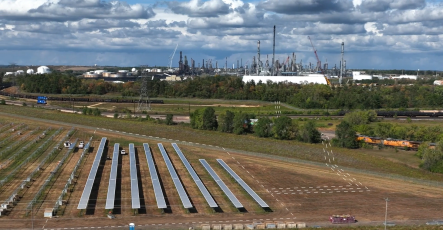While AFPM members continue to produce the traditional fuels and energy essential for our daily lives, they are also at the forefront of creating liquid fuels with lower lifecycle greenhouse gas (GHG) emissions to reduce emissions throughout the transportation sector. Here are some examples:
Renewable Diesel
What is it?
Renewable diesel is made from a variety of feedstocks, including vegetable oils, animal fats, used cooking oil, and even municipal waste. It is created through a hydrogenation process which converts the raw materials into hydrocarbons that are chemically identical to petroleum diesel. Renewable diesel can provide lifecycle greenhouse gas reductions on the order of 80 percent. These reductions are dependent on the feedstock, processing technology, and energy inputs.
How is it used?
Renewable diesel is used as a replacement for petroleum diesel in existing diesel engines and generators to reduce the carbon footprint of transportation and power generation.
In 2024, Phillips 66 completed the transition of its refinery in Rodeo, California into one of the world’s largest renewable fuels facilities. The Rodeo Renewable Energy Complex began producing roughly 30,000 barrels per day of renewable fuels in March 2024 and is expected to increase capacity to 50,000 barrels per day. The fuels produced will have up to 80 percent fewer lifecycle carbon emissions than conventional diesel.
Sustainable Aviation Fuel
What is it?
Sustainable Aviation Fuel (SAF) is a biofuel used in commercial aviation, produced from feedstocks like plant oil, animal fat and waste-derived materials. SAF has the potential to reduce lifecycle GHG emissions by up to 80 percent compared with conventional jet fuel.
How is it used?
SAF can be blended with conventional jet fuel and used in existing aircraft without modifications. This means airlines can start reducing emissions immediately without needing new infrastructure or technology before transitioning to SAF.
In October 2024, Valero reported that its large-scale SAF project at its renewable diesel plant in Texas, was mechanically complete ahead of schedule and under budget, and it was in the process of starting up. The SAF project provides optionality to upgrade approximately 50 percent of the plant's annual 470 million-gallon renewable diesel production capacity to SPK or neat SAF.
Renewable Natural Gas
What is it?
Renewable Natural Gas (RNG) is a type of biogas made from decomposing waste in landfills, livestock emissions, wastewater treatment, and other sources. According to the Environmental Protection Agency (EPA), RNG can reduce GHG emissions by up to 60 percent compared to natural gas.
How is it used?
RNG is used as a lower carbon alternative to traditional natural gas. RNG is a versatile and sustainable energy source that can be used for electricity generation, or it can be compressed and used to fuel trucks, buses, and other heavy transportation.
Chevron and Brightmark LLC have formed a joint venture, Brightmark RNG Holdings LLC, to fund the construction of infrastructure and commercial operation of dairy biomethane projects in several states. Chevron purchases renewable natural gas (RNG) from these projects and markets the RNG volumes for use in vehicles operating on compressed natural gas (CNG). Chevron has acquired ownership of 56 CNG stations nationwide through its purchase of Beyond6, LLC to provide an outlet for this RNG.
The American Fuel & Petrochemical Manufacturers (AFPM) is the leading trade association representing the makers of the fuels that keep us moving, the petrochemicals that are the essential building blocks for modern life, and the midstream companies that get our feedstocks and products where they need to go. We make the products that make life better, safer and more sustainable — we make progress.


